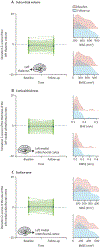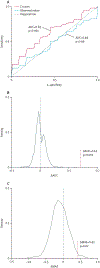Normative modelling of brain morphometry across the lifespan with CentileBrain: algorithm benchmarking and model optimisation
- PMID: 38395541
- PMCID: PMC10929064
- DOI: 10.1016/S2589-7500(23)00250-9
Normative modelling of brain morphometry across the lifespan with CentileBrain: algorithm benchmarking and model optimisation
Abstract
The value of normative models in research and clinical practice relies on their robustness and a systematic comparison of different modelling algorithms and parameters; however, this has not been done to date. We aimed to identify the optimal approach for normative modelling of brain morphometric data through systematic empirical benchmarking, by quantifying the accuracy of different algorithms and identifying parameters that optimised model performance. We developed this framework with regional morphometric data from 37 407 healthy individuals (53% female and 47% male; aged 3-90 years) from 87 datasets from Europe, Australia, the USA, South Africa, and east Asia following a comparative evaluation of eight algorithms and multiple covariate combinations pertaining to image acquisition and quality, parcellation software versions, global neuroimaging measures, and longitudinal stability. The multivariate fractional polynomial regression (MFPR) emerged as the preferred algorithm, optimised with non-linear polynomials for age and linear effects of global measures as covariates. The MFPR models showed excellent accuracy across the lifespan and within distinct age-bins and longitudinal stability over a 2-year period. The performance of all MFPR models plateaued at sample sizes exceeding 3000 study participants. This model can inform about the biological and behavioural implications of deviations from typical age-related neuroanatomical changes and support future study designs. The model and scripts described here are freely available through CentileBrain.
Copyright © 2024 The Author(s). Published by Elsevier Ltd. This is an Open Access article under the CC BY 4.0 license. Published by Elsevier Ltd.. All rights reserved.
Conflict of interest statement
Declaration of interests SSH is supported by the US National Institutes of Health (NIH)'s National Institute of Mental Health (T32MH122394) and received a travel award from the Society of Biological Psychiatry to attend the annual meeting in 2023. HB declares an institutional grant from the Australian National Health and Medical Research Council; has received compensation for being on an advisory board or a consultant to Biogen, Eisai, Eli Lilly, Roche, and Skin2Neuron; payment for being on the Cranbrook Care Medical Advisory Board; and honoraria for being on the Montefiore Homes Clinical Advisory Board. RMB and HEHP declare partial funding through the Geestkracht programme of the Dutch Health Research Council (Zon-Mw, grant No 10–000–1001) and matching funds from participating pharmaceutical companies (ie, Lundbeck, AstraZeneca, Eli Lilly, and Janssen Cilag), universities (Academic Psychiatric Centre of the Academic Medical Center, University Medical Center Groningen, Maastricht University Medical Centre, and University Medical Center Utrecht), and mental health care organisations (GGZ Ingeest, Arkin, Dijk en Duin, GGZ Rivierduinen, Erasmus Medical Centre, GGZ Noord Holland Noord, Lentis, GGZ Friesland, GGZ Drenthe, Dimence, Mediant, GGNet Warnsveld, Yulius Dordrecht, Parnassia psycho-medical center The Hague, GGzE, GGZ Breburg, GGZ Oost-Brabant, Vincent van Gogh voor Geestelijke Gezondheid, Mondriaan, Virenze riagg, Zuyderland GGZ, MET GGZ, Universitair Centrum Sint-Jozef Kortenberg, CAPRI University of Antwerp, PC Ziekeren Sint-Truiden, PZ Sancta Maria Sint-Truiden, GGZ Overpelt, OPZ Rekem, Altrecht, and GGZ Centraal and Delta); and received funding from Nederlandse Organisatie voor Wetenschappelijk Onderzoek (NWO 51·02·061 to HEHP, NWO 51·02·062 to DIB, NWO–NIHC Programs of excellence 433–09–220 to HEHP, NWO-MagW 480–04–004 to DIB, and NWO/SPI 56–464–14192 to DIB), FP7 Ideas: European Research Council (ERC-230374 to DIB), and Universiteit Utrecht (High Potential Grant to HEHP). RB declares funding by the NIH's National Institute on Aging (R01AG067420); received compensation for being on the scientific advisory board from Alkermes and Cognito Therapeutics with no conflict to the present work; received honoraria from academic institutions for talks (all under $1000) and $1000 for speaking at a Massachusetts General Hospital and Harvard Medical School course; received travel fees for services to attend the annual meeting from the Simons Foundation; serves as a Director on the Simons Foundation Collaborative Initiative on Aging; is a paid scientific advisory board member for philanthropic grants for The Foundation for OCD Research and the Klarman Family Foundation. BF has received educational speaking fees from Medice. DG reports funding from the NIH. UD is funded through the German Research Foundation (DFG; DA 1151/9–1, DA 1151/10–1, DA 1151/11–1). GS declares funding from the European Commission, DFG, and National Science Foundation of China. CKT has received grants from the Research Council of Norway and the Norwegian Regional Health Authority, unrelated to the current work. HW reports funding from the German Research Foundation (WA 1539/11–1). NJ reports funding from the NIH and compensation from the International Neuropsychological Society. PMT declares a grant from the NIH and travel funded by NIH grants. All other authors declare no competing interests.
Figures








Update of
-
Normative Modeling of Brain Morphometry Across the Lifespan Using CentileBrain: Algorithm Benchmarking and Model Optimization.bioRxiv [Preprint]. 2023 Dec 2:2023.01.30.523509. doi: 10.1101/2023.01.30.523509. bioRxiv. 2023. Update in: Lancet Digit Health. 2024 Mar;6(3):e211-e221. doi: 10.1016/S2589-7500(23)00250-9. PMID: 38076938 Free PMC article. Updated. Preprint.
References
-
- Potvin O, Dieumegarde L, Duchesne S, et al. NOMIS: quantifying morphometric deviation from normality over the lifetime in the adult human brain. bioRxiv 2022; published online Feb 23. 10.1101/2021.01.25.428063 (preprint). - DOI
-
- Villalón-Reina JE, Moreau CA, Nir TM, et al. Multi-site normative modeling of diffusion tensor imaging metrics using hierarchical Bayesian regression. In: Wang L, Dou Q, Fletcher P, Speidel S, Li S, eds. Medical image computing and computer assisted intervention—MICCAI 2022. Cham: Springer, 2022: 207–17.
Publication types
MeSH terms
Grants and funding
- P30 AG010133/AG/NIA NIH HHS/United States
- R01 AG067420/AG/NIA NIH HHS/United States
- R01 MH104284/MH/NIMH NIH HHS/United States
- R01 MH116147/MH/NIMH NIH HHS/United States
- R01 MH113619/MH/NIMH NIH HHS/United States
- T32 MH122394/MH/NIMH NIH HHS/United States
- U54 EB020403/EB/NIBIB NIH HHS/United States
- R01 HD050735/HD/NICHD NIH HHS/United States
- UL1 TR004419/TR/NCATS NIH HHS/United States
- UL1 TR000153/TR/NCATS NIH HHS/United States
- R01 CA101318/CA/NCI NIH HHS/United States
- U24 RR025736/RR/NCRR NIH HHS/United States
- R01 AG019771/AG/NIA NIH HHS/United States
- UL1 RR025761/RR/NCRR NIH HHS/United States
- P50 HD105351/HD/NICHD NIH HHS/United States
- R01 MH117014/MH/NIMH NIH HHS/United States
- R01 MH042191/MH/NIMH NIH HHS/United States
- U24 RR021992/RR/NCRR NIH HHS/United States
- R01 MH090553/MH/NIMH NIH HHS/United States
- RC2 DA029475/DA/NIDA NIH HHS/United States
- R01 AG059874/AG/NIA NIH HHS/United States

